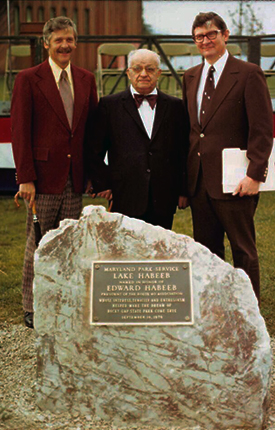History
According to legend, Jacob Evart was the first white, European (Englishman) settler to come to what is now known as Allegany County. He settled on top of the mountain that overlooks Rocky Gap. According to the story, Mr. Evart (the mountain is named Evitts Mountain), around 1730, moved to the wildlands of Western Maryland after suffering a disappointing relationship. Also named for Mr. Evart is the creek that Rocky Gap’s water ultimately empties into – Evitts Creek. The “Homesite Trail” leads hikers to the top of the mountain where Mr. Evart’s home once stood. Remains of a well are all that is left today.
The Bucy Cemetery is an excellent example of a 19th century rural cemetery. Originally owned by Caleb Luman, the land was sold to Lemel Bucy, whose family used the cemetery during the 1800’s, until the property was sold in 1900. The parcel of land passed through five owners before the Maryland Commission of Forests and Parks purchased it in 1964. The cemetery features many Civil War era stones, including for two children who perished only days apart.
The day-use area of Rocky Gap State Park is situated on the former Clover Hill Farm, a dairy farm that was owned and operated by the McLuckie Family throughout most of the 1900s until just before the park was established. Until 1998, the original Clover Hill barn stood just off of the Exit 50 ramp, at the park’s entrance. The McLuckie’s purchased 162 acres of land from Mr. Thomas Pownell, who had purchased a much larger tract of farmland that had been known as the Bretz Farm and encompassed much of present day Rocky Gap. At the time, portions of the land were known as “Clover Hill,” “Pleasant Valley” and “Great Friendship.”
 Mr. Edward Habeeb (pronounced Hay-Bib), President of the Route 40 Association, donated land to be established as a state park. He, along with approximately 40 other land owners, provided land and many were compensated $10.00 for their land, with the understanding that a park would be built on the property. The McLuckie Family was paid $100,000.00 for their portion of the land. Mr. Habeeb was a nearby resident. Although he was born in Beirut, Lebanon in 1895, he came to Allegany County in 1913, first settling in Westernport, before opening a florist business in Piedmont, and ultimately moving his business to what became Route 40 and is now Interstate 68. His home and business location still stand today.
Mr. Edward Habeeb (pronounced Hay-Bib), President of the Route 40 Association, donated land to be established as a state park. He, along with approximately 40 other land owners, provided land and many were compensated $10.00 for their land, with the understanding that a park would be built on the property. The McLuckie Family was paid $100,000.00 for their portion of the land. Mr. Habeeb was a nearby resident. Although he was born in Beirut, Lebanon in 1895, he came to Allegany County in 1913, first settling in Westernport, before opening a florist business in Piedmont, and ultimately moving his business to what became Route 40 and is now Interstate 68. His home and business location still stand today.
Pursuant to Senate Resolution 2 of the 1950 Special Session of the Maryland General Assembly, the Maryland State Planning Commission commissioned a recreational survey of Western Maryland. The idea of constructing a park at Rocky Gap was suggested by the Lions Club to Senator Charles See, who then presented the proposal to the Director of the Department of Forest and Parks, Mr. Joseph Kaylor. The Route 40 Association was then organized to promote business and industry in Allegany County through improved highways and a recreational facility at Rocky Gap. The organization, under the leadership of Mr. Habeeb (pictured in the center), obtained the support of Governors Tawes and Mandel. The beginning phase involved the purchase of the McLuckie’s farm in December of 1963, after which another 2,212 acres were acquired by December of 1966.
Rocky Gap State Park formally opened on July 17, 1974, in great part due to the efforts of Mr. Habeeb, for whom the park’s lake is named. In 1970, the dam was built by the Army Corps of Engineers to impound Rocky Gap Run and create Lake Habeeb. The 243-acre lake is typical of all Maryland lakes in that it requires a dam and is thus man-made. Maryland has no natural lakes. The park was dedicated on September 18, 1976. The campground opened to the public in 1978. Including the General Construction Loan of 1975, approximately $7.9 million was appropriated for land acquisition and development of Rocky Gap State Park.